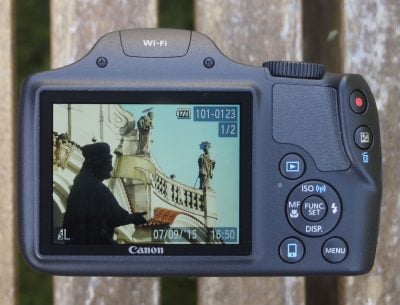Canon PowerShot SX530 HS review
-
-
Written by Ken McMahon
In depth
The Canon PowerShot SX530 HS is a super-zoom camera with a 50x optical zoom lens. Launched in January 2015 it’s an update to the PowerShot SX520 HS launched just six months previously. As is often the case when new Canon compacts are introduced, the older model remains in the line up for now.
As well as increasing the zoom range from the 42x of the SX520 HS, the new model re-introduces Wifi. Go back two generations and the SX510 HS was Wifi equipped, but it was inexplicably dropped from the SX520 HS, so its return is very welcome and hopefully it’s back to stay. In the new model the Wifi is augmented with NFC for straightforward initiation of a wifi link by tapping the camera with a suitably equipped smartphone.
The SX530 HS shares the same 16 Megapixel CMOS sensor as its predecessor and also retains the 3 inch 461k dot LCD screen. The mode dial is unchanged with the same PASM modes in addition to Auto, the novice-friendly Live View Control and among other things scene modes and Creative effects. As before, there are special Framing Assist features to help keep your subject framed when zoomed in. Essentially then, the SX530 HS adds a longer zoom range and addresses one of the earlier model’s biggest drawbacks, the lack of Wifi. Here I’ve tested and compared it alongside Canon’s budget compact bridge super-zoom, the PowerShot SX410 IS and Nikon’s Budget COOLPIX L840. Read on to discover if the SX530 HS is worth laying out the extra cash for, or whether a less expensive model might suit you just as well.
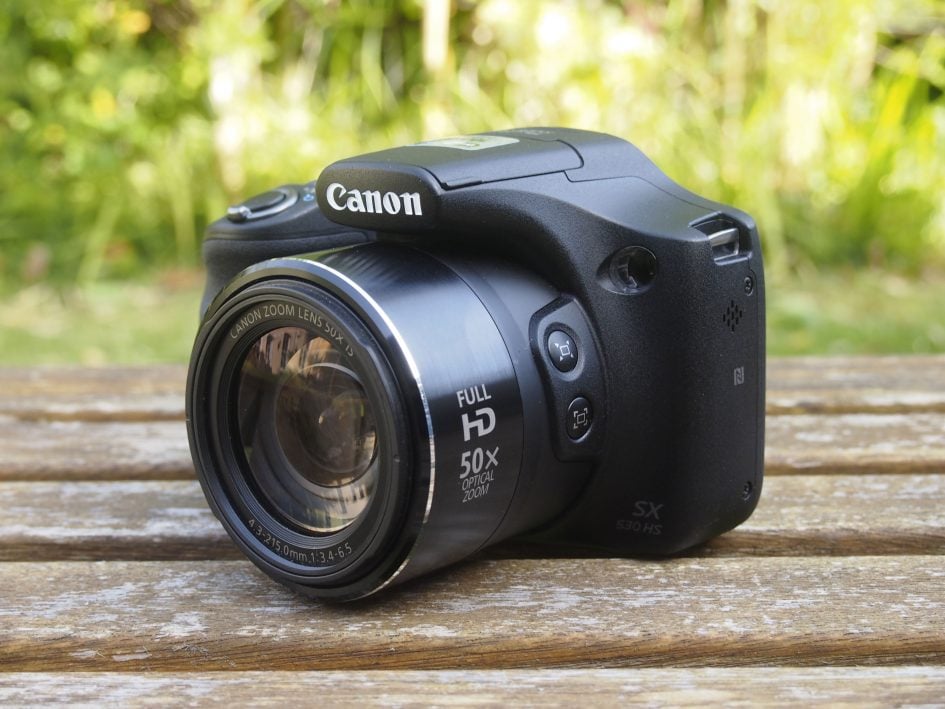
Canon PowerShot SX530 HS design and controls
The SX530 HS not only looks the same as its predecessor, it is the exact same size and weight too, which is something of an achievement considering it has 50x optical zoom compared with ‘only’ a 38x zoom in the earlier model.
As bridge super-zooms go it’s actually quite compact and in fact is similarly sized to the COOLPIX L840, though the latter is substantially heavier, mostly on account of its AA batteries. But if you’re looking for a really compact and light-weight super-zoom, the PowerShot SX410 IS is the one to go for.
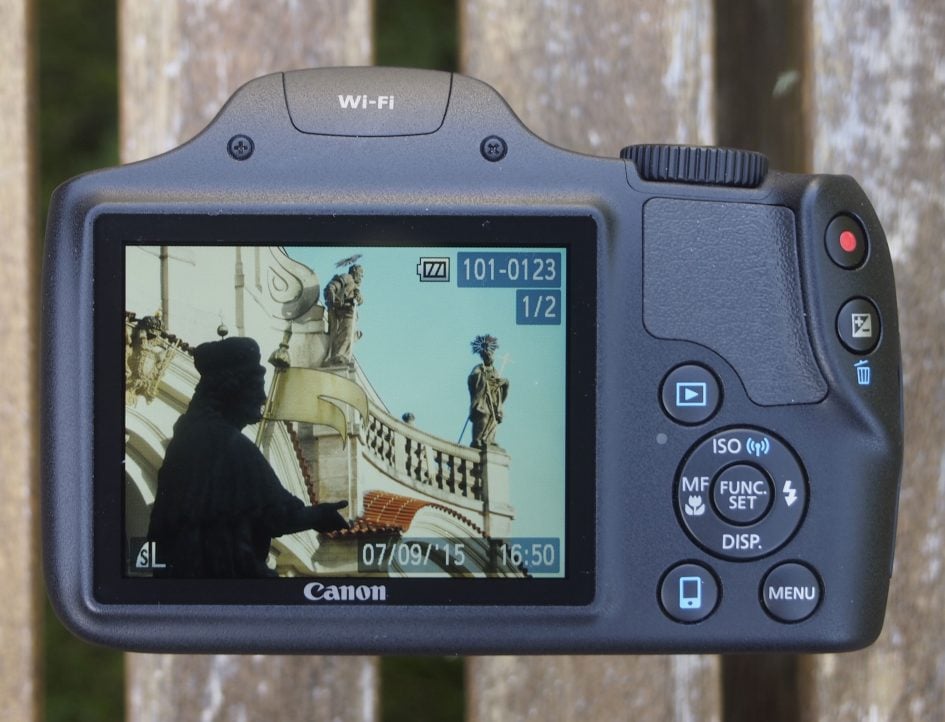
On the SX530’s top panel to the right of the flash there’s a slightly recessed on/off button; I found it a little difficult to get to, but on the up side there’s no way it’s going to get pressed accidentally. To the right of it is a large plastic mode dial and between that and the shutter release is the control dial which is operated with your index finger. This controls exposure in the PASM modes.
Moving round the the back, the control layout is more or less identical to the the SX520. The four-way controller has settings for ISO, flash, display and focus mode on the cardinal points and a Func. Set button for accessing the quick menu in the middle. Additionally the top position now also activates the Wifi in playback mode.
Below it are a menu button and in place of the earlier model’s continuous shooting mode button there’s a button to connect with your phone via Wifi. The playback button sits above the four-way pad and two remaining buttons, movie record and exposure compensation are located on the raised, rounded edge to the right of the thumb pad. Overall it’s an arrangement that works well.
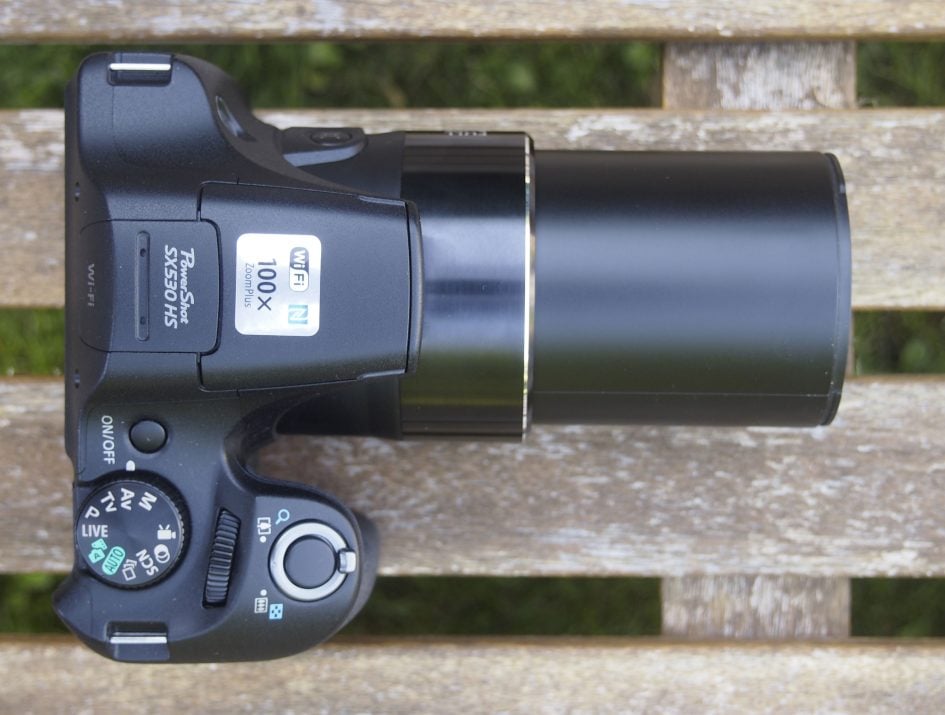
A rubber-like flap on the right side of the camera body covers the SX530’s combined USB / A/V out and mini HDMI ports, and on the base a narrow plastic door provides access to the combined battery and card compartment. The SX530 HS takes the same NB-6LH battery as its predecessor which, as before, lasts for 210 shots on a full charge. That’s not going to deliver a full day’s shooting unless you’re very frugal, but switch to Eco mode and you can squeeze 290 shots from a fully charged battery. Eco mode dims the screen after a couple of seconds inaction, then turns it off ten seconds later, and after a further three minutes turns the SX530 HS off altogether.
The SX530 HS has a built-in pop-up flash unit that you activate by raising it with your fingers. You can set one of four modes – Auto, on, slow synchro and off – using the right position on the rear pad. The flash has a maximum distance at the wide angle lens setting of 5.5 metres or for more power you can fit the PowerShot SX530 HS with Canon’s HF-DC2 external flash.
The SX530 HS has a fixed LCD screen that measures 3 inches diagonally. It has a resolution of 461k dots, which puts it in the middle between the 230k screen of the SX410 IS and the higher resolution 921k dot screen of the COOLPIX L840. And in terms of the clarity of the display, that’s exactly how it looks – the SX530 HS display is crisper and more detailed than the SX410 IS, but the Nikon COOLPIX L840’s display is the most detailed. Resolution isn’t everything though, and the COOLPIX L840’s ability to flip the screen up and down gives it an added advantage, you can adjust it to keep the sun off as well as shoot from high and low angles more comfortably.
Incidentally, all of these screens, including the SX530 HS’s are 4:3 proportioned which means that full resolution photos fill the entire screen area. However, when you shoot 16:9 HD video black bands appear above and below the image. That makes it difficult to frame up your shot because you’ll see a 4:3 view until you press the movie record button, at which point the top and bottom of your frame is cropped. Here’s where the SX530 HS wins out over the SX410 IS and COOLPIX L840 with a dedicated movie position on its mode dial which, among other things, shows exactly what you’ll get on the screen, allowing you to accurately frame up your shot before you press record.
Canon PowerShot SX530 HS lens and stabilisation
The PowerShot SX530 HS has an updated lens with an optical zoom that increases in range to 50x. The earlier SX520 HS sported a 38x zoom which was itself an update on the 30x zoom of the SX510 HS.
The SX530 HS now offers one of the longest zoom ranges available on a fairly compact bridge model. There are a handful of models that outreach it, like the 65x Canon PowerShot SX60 HS and Nikon’s 83.3x COOLPIX P900, as well as models from Sony, Olympus and Fujifilm, but 50x is in the top tier. The range starts at the same 24mm equivalent focal length as the earlier model, but extends beyond the SX520 HS’s maximum 1008mm equivalent to 1200mm.
Canon PowerShot SX530 HS coverage, wide and tele

Above: Canon PowerShot SX530 HS at 4.3mm (24mm) and at 215mm (1200mm)
The optical zoom range is one of those numbers that people get excited about. All other things being equal, why wouldn’t you choose a 50x zoom over a 40x or a 38x? But it’s difficult to visualise just how much of a difference those numbers make in the real world. The comparison below gives you an idea of how much closer you’ll get when zoomed in to the maximum on the 50x PowerShot SX530 HS compared with the 38x Nikon COOLPIX L840.

Above left: Canon PowerShot SX530 HS at 215mm (1200mm). Above right: Nikon COOLPIX L840 at 152mm (855mm).
Another thing to consider is the maximum wide angle focal length which on the SX530 HS, as on the SX410 IS is 24mm compared with a slightly wider 22.5mm on the COOLPIX L840. The difference at this end of the range is marginal though. 24mm is plenty wide enough for sweeping landscape shots, large group photos and small interiors.
Finally, if we’re making a numbers comparison, there’s the maximum aperture to consider – f3.4 – 6.5 on the SX530 HS compared with f3.5 – 6.3 and f3 – 6.5 on the SX410 IS and COOLPIX L840 respectively. So the COOLPIX L840 is a little brighter at the wide angle setting, but there’s little in it at the telephoto end. Just remember though that the f6.5 maximum aperture of the SX530 HS is fully zoomed in to 1200mm equivalent. When it’s zoomed in to around the 855mm equivalent maximum of the COOLPIX L840 you can still use f5.6. Plus the SX530 HS has Aperture priority exposure mode so you can choose the brightest available aperture rather than trusting to Program auto mode as on the SX410 HS and L840.
Canon PowerShot SX530 HS Image Stabiliser off / on

Above left: 100% crop, 4.3-215mm at 215mm, 1/40, 100 ISO, IS off. Above right: 100% crop, 4.3-215mm at 215mm, 1/40, 100 ISO, IS Continuous
The SX530 Hs is equipped with Canon’s Intelligent IS stabilisation which uses scene detection to set the most appropriate mode. It has has three modes which are selected from the shooting menu – Off, Continuous, and Shoot only. The last one activates the stabilisation a fraction of a second before exposure, saving on battery power, but missing out on the steadier viewfinder image. I tested the stabilization on the SX530 HS by selecting Shutter priority mode, zooming the lens to its maximum 1200 mm equivalent telephoto and taking a series of shots at progressively slower shutter speeds, first with the stabilisation off and then in continuous mode. As you can see from the 100 percent crops above, you can hand-hold the SX530 HS at speeds down to 1/40, amounting to an impressive five stops or so of stabilisation. I was occasionally able to get sharp shots at 1/20th, but 1/40 produced consistently good results.
Canon PowerShot SX530 HS movie modes
The SX530 HS has a dedicated movie record button on the shoulder of the body to the right of the thumb pad. Press it in any mode and movie recording begins with the exposure set automatically. There’s a movie position on the mode dial which switches the display to 16:9 proportions with black bars top and bottom in HD movie modes, but doesn’t allow any manual control over exposure or ISO settings. You can, however, change exposure compensation by +/- 2 stops prior to recording.
Like its predecessor, the SX530 HS has a 1080 / 30p full HD mode plus 720p30 and VGA (640×480) also at 30fps. Movies are encoded using the H.264 codec and saved as QuickTime files with a .mov extension in the same folder as still images. I measured the average bit rate of movies recorded in the 1080p30 mode at around 30 Mbit/s. So a 4-5 minute clip will occupy around a Gigabyte of card space. The limit on continuous recording is when the file size reaches 4GB or a second short of 30 minutes. Canon recommends using a Speed Class 4 or higher memory card.
The PowerShot SX530 HS retains the Hybrid mode of its predecessor which records a short movie clip prior to each still image you shoot and automatically assembles them into a movie. It’s an inspired idea and remains one of the best movie features of Canon compacts. Disappointingly though, 1/4 and 1/8 speed slow motion recording options of the SX510 HS which were dropped on the SX520 HS haven’t been re-introduced nor are there any other new movie modes.
Download the original file (Registered members of Vimeo only)
This clip, like the others below was shot in the PowerShot SX530 HS’s best quality 1080/30p mode. The quality looks good and the stabilisation does a great job during the pan when the lens is at the wide angle setting. The noise from the zoom motor is a little intrusive though and with the lens fully zoomed in the stabilisation struggles.
Download the original file (Registered members of Vimeo only)
For this second clip the camera was mounted on a tripod and the stabilisation was disabled. Again, the quality looks good, though there’s noticeable colour fringing at the edges on this clip. This time around there’s little audible noise from the zoom motor and the AF does a good job of keeping the subject sharp.
Download the original file (Registered members of Vimeo only)
This panning shot in a dimly lit bar is a little noisy, but the PowerShot SX530 HS makes a good job of the exposure and the white balance is good with nicely saturated colours. Once again the Intelligent IS stabilisation keeps the pan wobble-free.
Download the original file (Registered members of Vimeo only)
For this clip I tested the PowerShot SX530 HS’s continuous AF performance by zooming the lens in slightly and panning from the coffee cup on the table up to the bar and back again. The SX530 HS is a little slow to adjust focus, but does so unobtrusively and without over-shooting and having to correct.
Download the original file (Registered members of Vimeo only)
Here’s the PowerShot SX530 HS Miniature mode in action. You have to remember to set the aspect ratio to 16:9 in the quick menu for 720p HD video, but you can at least now set this separately from the 4:3 aspect ratio used in other shooting modes. You just have to remember to set it back to 4:3 if you want to shoot Miniature mode stills.
Canon PowerShot SX530 HS shooting experience
The only means of composition on the PowerShot SX530 HS is the screen and when shooting with the lens zoomed in to its maximum 1200mm equivalent focal length it can be pretty challenging keeping your subject in the frame, particularly when it’s moving.
Canon has thoughtfully provided a couple of features to help with that. A prolonged press of the dedicated Framing Assist Seek button on the side of the lens barrel temporarily zooms the camera out to show a wider field of view, revealing anything you might have lost, leaving a small frame in the middle indicating the coverage at the previous zoom position. Releasing the button returns the zoom back again.
Press the Frame Assist Seek button once and it’ll also present a series of options to help you keep a subject in the frame for photos or video. For example you can choose face, upper body or whole body and once the camera has locked-onto the subject it’ll adjust the optical zoom to maintain their approximate size on the frame. So if someone walks towards you, the camera will automatically zoom wider in steps. If the person is lost to the side of the frame, the camera zooms wider to include them again, and if they move away, it increases the zoom, again to roughly maintain their original size.
The camera has a threshold at which point it adjusts the zoom, so rather than a smooth and constant rack, it’s more of an occasional lurch. This can sometimes jar when filming video, but the bottom line is it really can keep a subject in the frame quite successfully.
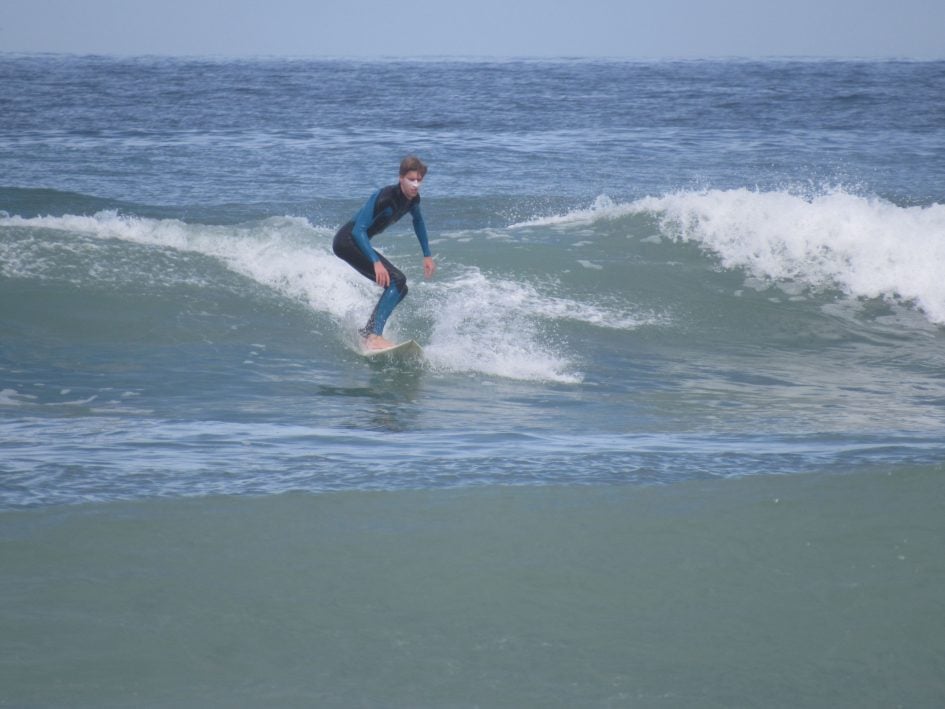
Above: 1/320, f6.5, 100 ISO, 215mm (1200mm equivalent)
Below the Frame Assist Seek button there’s a second button called Framing Assist Lock which activates the Intelligent IS stabilisation to help keep things steady while you compose your shot. Interestingly, even if you have Intelligent IS set to continuous, pressing the Framing Assist Lock button makes the viewfinder image appear even steadier. I didn’t test this to see if it improved shooting stabilisation, but I think it’s fair to assume it doesn’t and the safest approach is to set the IS to Shoot only or Continuous and use Framing Assist Lock purely as a compositional aid.
The SX530 HS starts swiftly and the AF system generally locks onto subjects with ease in good conditions. In decent light at wide focal lengths, the AF is almost instant, and even with the camera fully zoomed-in in good light and with a contrasty subject you’re looking at less than a second. As light levels drop though, the AF system inevitably becomes more sluggish, which could prove frustrating if you’re attempting to shoot sports in dim conditions. There were occassions when shooting with the SX530 HS in twilight where it struggled to focus at all. That said, the PowerShot SX410 IS and Nikon COOLPIX L840 fared no better in this respect and at least the SX530 HS can offer Manual focus as an alternative.
Probably my biggest complaint with the AF system though is the inability to reposition the single AF area manually. If you choose single area, then it’s permanently locked to the middle of the frame (though you can opt for one of two AF Area sizes). If you’d like the camera to focus elsewhere on the frame, you’ll have to switch it to Face / AiAF mode and hope it recognises the desired subject. To be fair the SX530 HS does a good job at subject recognition in the auto modes, but there are times when I like to reposition the AF area manually and sadly it’s not possible here.

Above: 1/800, f4, 100 ISO, 4.3mm (24mm equivalent) Program Auto, Macro
The SX530 HS offers two continuous shooting options; a full resolution mode at 1.6 frames per second and High speed burst mode which shoots 4 Megapixel images at 10fps. I won’t spend too much time talking about the full resolution mode as it’s so slow it’s almost not worth bothering with. Let’s just say that with exposure and focus locked on the first frame if your subject is moving towards or away from the camera at faster than walking pace its unlikely that anything other than the first frame will be in focus.
In High Speed burst mode focus and exposure are locked on the first frame, but at 10fps you can at least capture a decent action sequence. I tested it with a freshly formatted speed class 10 SD card and it shot continuously at a steady rate which I timed at slightly faster than 10fps for more than 20 seconds; had I kept the shutter pressed it would probably have continued until the card was full.
So in practice the High speed burst mode is a lot more useful providing you’re prepared to put up with smaller images. One other limitation is that the ISO sensitivity is set automatically. If you don’t like the sound of that, the Nikon COOLPIX L840 offers a full resolution burst of 7 frames at 7.4fps plus a wealth of lower resolution continuous shooting options. See my Nikon COOLPIX L840 review for more details.
The PowerShot SX530 HS is equipped with Wifi and NFC for wireless remote control and image transfer with iOS or Android handsets running the free Canon Camera Connect app. Like most camera Wifi implementations, the SX530 HS sets itself up as a wireless access point which your phone needs to connect to. The process is very simple if you have a phone with NFC, if not it’s still pretty straightforward. On an iPhone for example, having pressed the mobile device connection button on the rear of the camera, you need to go to Settings, then Wifi, select the SX530 HS SSID from the list of networks and then launch the app.
Once connected the Camera Connect app offers three options: Images on camera, Remote Shooting and Location information. The first presents thumbnails of the images stored in the camera and lets you view their details and copy them across, either resized (in my case to 3.5 Megapixels) or in their original format.
The Remote Shooting option presents a live image of what the camera sees, but beyond adjusting the zoom and setting a self-timer, options are extremely limited. The biggest disappointment initially is that you can’t adjust focus by tapping the screen. But that’s quickly superseded by the realisation that you can’t change exposure settings. Even if the mode dial is set to one of the PASM positions it isn’t possible to adjust the aperture or shutter speed, or even to set exposure compensation. It appears that the exposure is determined automatically regardless of the mode dial position. Not surprisingly in view of these limitations, you can’t change the ISO sensitivity, white balance, or anything else.
The third option from the home screen is location information which allows you to record a position track-log using your phone’s GPS and then use it to add location information to photos on the card in the camera.
Finally, if you choose to connect to a wireless access point during playback on the SX530 HS, you can upload images directly from the camera to various social services including Flickr, Facebook, Twitter, YouTube, Google Drive, or a direct image sync with your computer. As with previous models, sharing to social services actually just uploads your image to Canon’s own Image Gateway service which then posts on your behalf (given sufficient permissions via a web configuration).
For most people, myself included, the primary purpose of Wifi is to transfer photos to a smartphone so they can be shared one way or another. The SX530 HS and Camera Connect app make that possible in a simple fuss-free manner. The remote shooting features are frustratingly basic, but then the Nikon COOLPIX L840 offers similarly basic remote shooting.
The PowerShot SX530 HS shares the many of the same shooting modes as its predecessor, including of course the traditional PASM modes, (or P, Tv, Av and M as they’re denoted on all Canon cameras) and Smart Auto with scene detection capable of identifying 32 scene types including moving subjects, backlighting, sunsets and close ups, as well as when you’ve got the camera on a tripod, and adjusting the exposure accordingly.

Above left: PowerShot SX530 HS : Fish-eye Effect. Above right: PowerShot SX530 HS : Toy Camera Effect.

Above left: PowerShot SX530 HS : Monochrome. Above right: PowerShot SX530 HS : Super Vivid.
The Live View control position on the mode dial provides a simple interface for novices to experiment with exposure compensation, saturation and white balance via three sliders labelled Dark/Light, Neutral/Vivid and Cool/Warm. It’s a small step from here to switch to Program mode and use the exposure compensation button, or press the Func. button and alter the white balance setting from the Func. menu. Canon’s Hints and Tips feature provides some explanation of these more advanced settings.
The Creative filters position provides six effects – Fish-eye, Miniature, Toy camera, Monochrome, Super-vivid and Poster – most of which offer several variants. The Miniature mode is one of the most versatile ’tilt shift’ effect filters around and allows you to flexibly position the focus zone in the frame in either landscape or portrait orientation. Along with the Monochrome, Super-vivid and Poster Creative filters it can also be used for movie shooting.
Creative Shot mode is an extension of the filter effects which automatically applies a selection of them to a shot to produce six variations. The SX530 HS uses scene detection to determine which effects to apply and it also crops some images to produce new compositions. All six versions are then displayed for a couple of seconds and if you press the Func Set button you can review them individually though, of course, you can play them back at any time just like other shots. The SX530 HS also includes the Smart shutter modes which automatically fire the shutter when a smile is detected or start the self time when you wink or when a new face enters the frame.




